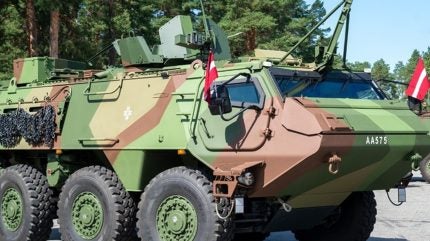
Latvia has officially joined the ranks of nations capable of manufacturing military vehicles, with the handover of the first Patria 6×6 armoured personnel carrier produced entirely within the country.
The milestone highlights Latvia’s growing defence autonomy and the role its burgeoning defence industry will play in the nation’s security.
In an event for Latvia’s defence industry on 5 August, the Latvian National Armed Forces (NAF) received the first Patria 6×6 armoured personnel carrier produced domestically. The delivery, which took place at the Ādaži military base, boosts the country’s military capabilities but also reveals its emerging role in the defence manufacturing sector.
The Patria 6×6 has a length of 7.5m, a height over the hull of 2.5m, and a width of 2.9m. According to GlobalData’s intelligence on the Latvian defence market, it can travel 700km before it needs to refuel and reach a top speed of 100km/h.
This event represents the fruition of a 2020 agreement between the Latvian Ministry of Defence and Patria, a Finnish defence contractor. The contract, which includes an order for over more than vehicles to be delivered by 2029, is part of a broader effort to enhance the NAF’s operational strength while fostering local industry.
It marks a moment in Latvia’s defence strategy, positioning the country as a capable producer of military hardware. With the opening of the Valmiera plant in May, the nation has secured a degree of defence self-sufficiency and has laid the groundwork for future industrial growth within the region.
Uģis Romanovs, chairman of the board of Defence Partnership Latvia and Patria Latvia, highlighted the broader implications of this development, stating: “We are also actively working to implement other NAF capability development projects in our factory, thereby strengthening both NAF combat capabilities and the Latvian industry and economy as a whole.”
The Valmiera plant is currently the only facility in the Baltics, with plans to produce approximately 30 Patria 6×6 armoured vehicles annually. This production capacity meets the immediate needs of the Latvian military and places the country on the map as a player in the defence manufacturing industry, particularly within the Baltic region.
This development also comes during heightened security concerns across Europe, emphasising the importance of having domestically-produced defence systems. With its participation in the multinational Common Armoured Vehicle System (CAVS) programme, Latvia is now part of a larger network of European nations—including Finland, Sweden, and Germany—working together to enhance their collective defence posture through standardised military platforms.
The Patria 6×6 armoured vehicle, chosen as the platform for the CAVS programme, has already been deployed operationally in Finland and Sweden, with orders continuing to grow. The programme remains open to other European countries, allowing Latvia to export its locally produced vehicles, potentially turning Valmiera into a regional hub for military production.
With the first vehicle now in the hands of the NAF, Latvia is poised to take its place as a contributor to regional security and stability.




